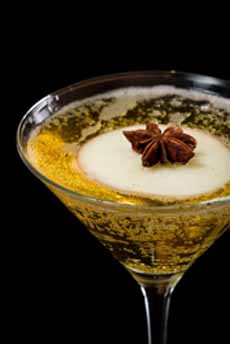RECIPE: Autumn Apple Spritz Cocktail With Lady Apples
|
Appletinis evoke spring and summer; mulled cider is for the chilly fall and winter. In-between, how about an Apple Cider Spritz? We adapted this recipe from one from Elegant Affairs Caterers. The basic recipe is very versatile, and a lesson in the ease of substituting ingredients. Ingredients Per Drink 1. COMBINE the vodka, apple juice, club soda and a squeeze of the lime wedge. Shake with ice until mixed and strain into a Martini glass or a coupe (the “sherbet champagne” glass). 2. TOP a slice of apple with the star anise and float atop the drink. The Lady is an old French variety, which remains popular in Europe and the U.S. It is known in Europe as the Api, after the forest of Api in Bretagne, in western France, where it is thought to have originated. It is a petite apple—an adult can finish it in three large bites—with a pleasing aroma and flavor. In photo #2, you can see how many fit into a pint container. Throughout its history, the Lady apple has been used as much for decoration as for eating apple. Baskets of Lady apples were used to mask unpleasant odors. |
 [1] An Apple Sprizer bridges the gap between warm-weather Appleton’s and cold weather Mulled Cider (photo courtesy Elegant Affairs caterers).  [2] Lady apples, called Api (their original name) in Europe (photo courtesy Simply Beautiful World | Tumblr). |
|
|
Records suggest that Api appeared as a seedling some time before the early 17th century. It soon became popular in France, England and the U.S. Records also show that the U.S. exported large quantities to England in Victorian times under the name Lady Apple [source]. In modern times, Lady apples are popular in the fourth quarter, as in centerpieces and other holiday decor, along with clementines, evergreen branches and pine cones. The Lady apple/Api is not directly related to either Pink Lady or Lady Alice apples. |
||


